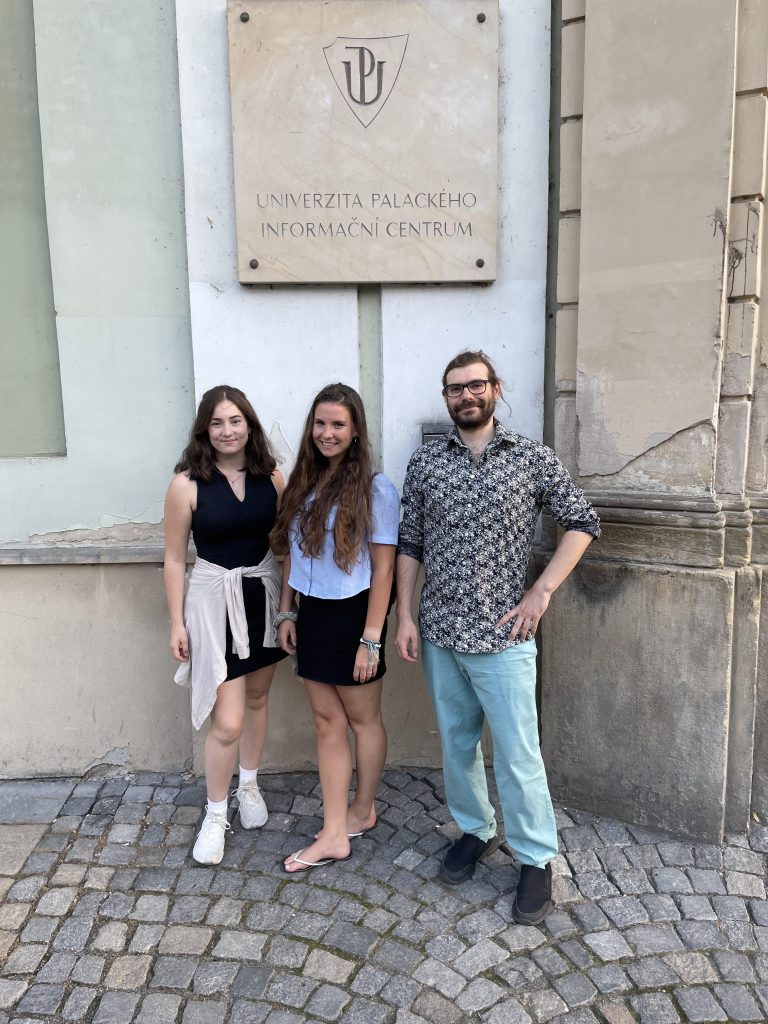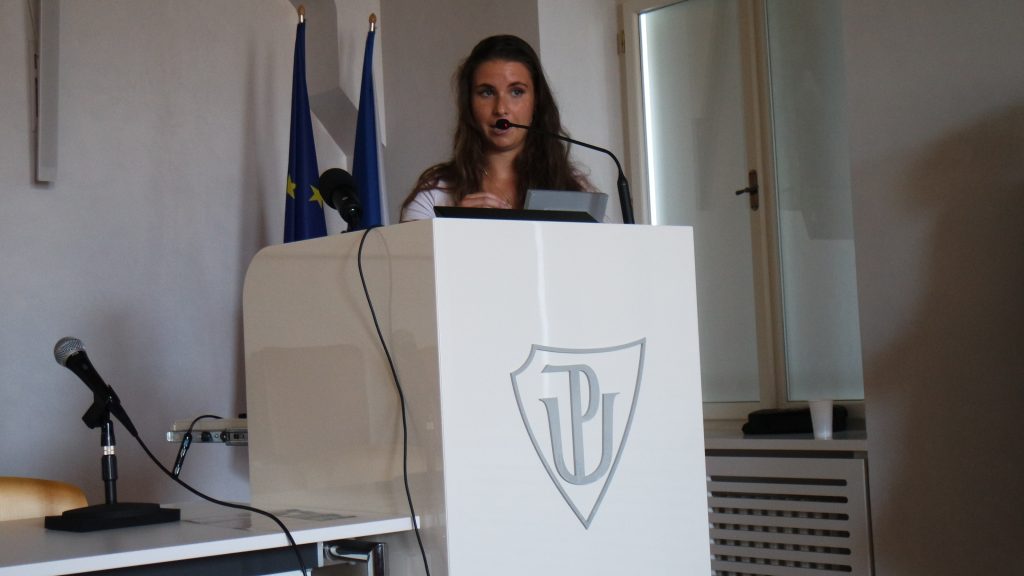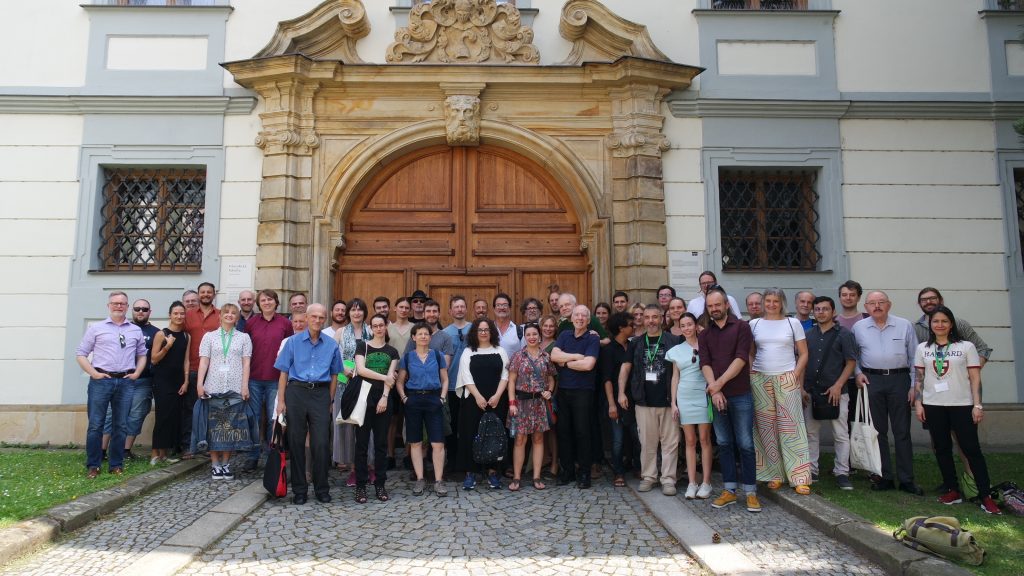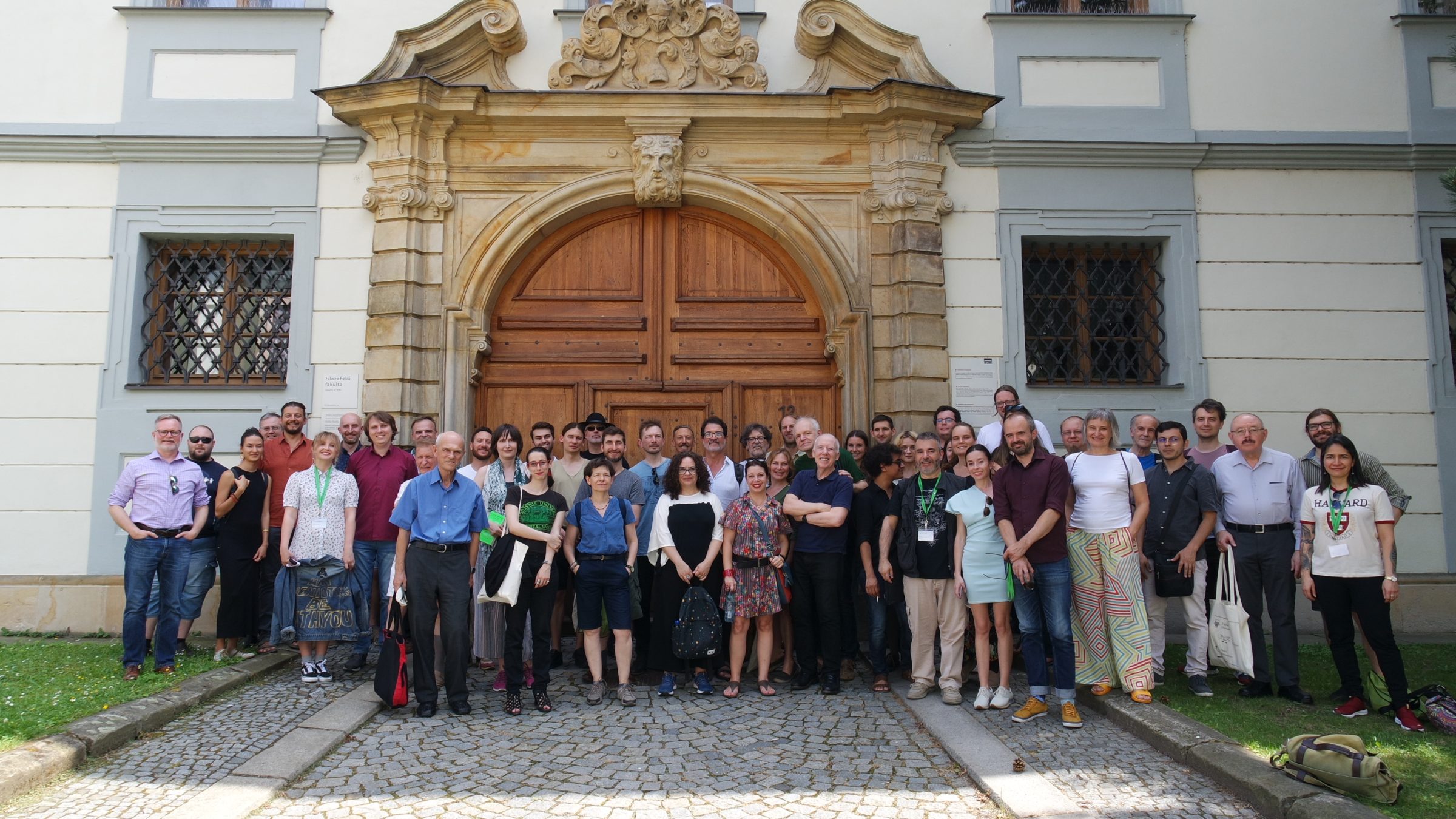CHIARA SCHUMANN AND JULE JANßEN

As the first RWTH Aachen University students benefitting from the new Erasmus Blended Intensive Program (BIP) funding scheme, we wrote this text to convey our personal experiences to academics and university managers but especially to other students, who might be thinking of using Erasmus BIP.
We used this type of funding to participate to the 22nd Gathering in Biosemiotics, in the Czech Republic. We very much enjoyed attending this conference, organized by the International Society for Biosemiotics. Not only did this open new professional horizons for us, but it was also a very fun experience. Attending this event by using Erasmus funds was made possible by Dr. Ľudmila Lacková and her team, who arranged such a funding program at this conference, which was hosted at Palacky University Olomouc from June 25th to July 1st, 2022. We would like to thank Dr. Alin Olteanu, who facilitated our participation to the conference from the RWTH Aachen end. We met Alin through a BA introductory seminar to semiotics that he teaches, part of an interdisciplinary module at our faculty. Through this seminar, we became fascinated with semiotics.

Chiara Schumann & Jule Janßen
Chiara Schumann and Jule Janßen are both B.A. students in Linguistics and Literary Sciences at RWTH Aachen University.
Chiara Schumann is interested in the interdisciplinary fields Bio- and Zoosemiotics as well as Neuro- and Psycholinguistics. In her B.A. work, she considers animal behaviour data in light of concepts from cognitive linguistics and Charles S. Peirce’s semiotics. In this way, she aims to contribute to the state-of-the-art in animal cognition.
Jule Janßen is interested in semiotic approaches to notions of linguistics, among which, primarily, mental lexicon and language evolution. She aims to explore grounding these concepts in ontological discussions on the relation between mind and body. Given her interest in semiotics, she intends to work further on the interface between linguistics, cognitive science and semiotics. She hopes to contribute to the interdisciplinary study of language development.
The 22nd International Gathering in Biosemiotics (2022) comprised 65 talks, by renowned researchers in the field, some excavating in detail, others orbiting or framing the discipline’s colorful spectrum with multidisciplinary questions on the study of living systems. Hosted by Palacký University Olomouc in Czechia, the conference program was excellently organized by the Department of General Linguistics – Ľudmila Lacková, Claudio J. Rodríguez Higuera, Tyler J. Bennet and their colleagues. The entire conference was live-streamed on YouTube. It is accessible on the channel “Biosemiotics Palacký University in Olomouc”.
Biosemiotics bridges natural sciences and humanities by approaching classical issues of biology (for example, DNA replication or various modes of intra- and interspecific animal communication) from a reflective point of view, in the interrogation of sign exchanges within and between organisms. Expanding the investigations of pioneers like Thomas A. Sebeok, Jesper Hoffmeyer and John Deely, the semiotic study of biological organisms generally draws on basic questions like: How do cells of flora and fauna create meaning? What stimuli are engaged in species specific perception? How does biosemiosis contribute to the understanding of human and non-human cognition and what should the study of life encompass, theoretically and practically?
The Gathering started with two pre-conference workshops that particularly addressed students and early career researchers. Prof. Dr. Elize Bisanz, who holds the Charles Sanders Peirce Interdisciplinary Chair at Texas Tech University hosted the workshop “The Future of the Humachine”, with a digital humanities focus. This covered topics such as the impact of AI and digitalization both on the biopshere as well as on cultures and societies. Discussions led to questions on whether we can implement in machines an ability to experience meaning, in a Peircean semiotic construal. To shed light on the diversity and variation of sign systems in the human world, graduate and undergraduate students were asked to present an artistic object of their choice analyse their subjective experience of it within the semiotic notion of meaning as triadic relation of ‘representamen’, ‘object’ and ‘interpretant’. As BA students, we were excited to speak in front of this impressive audience. Debates emerged based on our inputs and the feedback we received was kind and constructive.
Doc. RNDr. Anton Markoš and Dr. Jana Švorcová (Charles University in Prague) led the second workshop, “Life as a Semiotic Category”, which addressed the work and heritage of John Deely. This started with the consideration of ‘cellular closure’ and ‘mutual communication within cell ensembles’. Participants were led through a reflection on the remarkable fact that the minimal equipment of prokaryotes, say mouth, flagellum, organs, and a protective skin turned out so phylogenetically irreducible and effective that these characteristics still determine the appearance of higher animals and their immanent semiotic processes.
Honoured with the dreamlike location of a baroque chapel, the Gathering started on Monday with warm welcoming words by Donald Favareau and Kalevi Kull, veterans of biosemiotics. Claudio Rodríguez Higuera opened the first panel of talks, followed by other very important scholars in biosemiotics, Morten Tønnessen and Timo Maran. Thanks to the diverse educational backgrounds of the presenters, each day’s panels were filled with the most thought-provoking talks, from sign exchange on the level of the genetic code and cells over embodiment, endo- and exo-semiosis, Uexküll’s notion of Umwelt and Peirce’s sign theory and up to metaphysical approaches to the universe and God concepts. While the speakers of the first day provided general, though highly inspiring and sophisticated overviews of topics like ‘zoosemiotics’, ‘organism intersubjectivity’, ‘iconicity’ and ‘cognitive metaphoric approach to the genetic code’, on the next days presentations zoomed in on more specific and detailed issues.
Here, we briefly overview a few among the many intriguing talks. To begin with, we highlight Josh Bacigalupi’s presentation of his heuristic model of semiogenesis, inspired from Gilbert Simondon’s theory of individuation. This aims to offer a better and updated theoretical support for Peirce’s notion of sign as triadic. Coming from an interdisciplinary background of environmental sciences, chemistry and architecture, his approach is located at the interface between design and the maintenance of vitality in life systems. We found it an inspiring and creative approach.
Anton Markoš and Jana Švorcová discussed symbiogenetic dependency across species, in a talk titled “we, the cyborg”. Their argument starts from a criticism of one-way construals of relationships in the biosphere: species are interdependent as they are suppliers in some relationships and receivers in others. With reference to the notion of a cyborg, they lay focus on a collaborative rather than a competitive model and thus draw attention on collaboration as a principle that is essential not only for evolution, but also, more specifically, for scientific work.
Dr. Jamin Pelkey held a captivating talk on “analogy in evolution: a Peircean biosemiotic perspective”. More than convincing, the talk offered an inspiring and original language view on development. Jamin Pelkey showcased the language development of his own daughter, with examples of her linguistic expressions. By showing how his daughter went from calling her long green building block a ‘/kini/’ based on the similarity to a zucchini to naming her red and blue blocks ‘red’ and ‘blue’ ‘/kinis/’, but not her yellow block (named ‘/nænə/’ for banana), he demonstrated the importance of iconicity and analogy, automation and diagrammatization in language evolution.
We also highly appreciated the presentation of Yogi Hendlin and Matthew Slayton and of Martin Švantner. These presentations on “the musical turn in biosemiotics – an expressivist model of communication” and, respectively, “missing simple musicalities: the incomplete nature of music”, innovatively drew on (zoo)musicological studies to discuss communication, broadly. The co-development and particularly shared interpretable quality of music and language in the biosphere led Hendlin and Slayton to uncover musical qualities in some iconic and aesthetic aspects of meaning-making in general. Švantner explored the consequences of imputing music with expressions of a “simple language”.

As we see it, most talks revolved either around the topic of endosemiosis (semiosis taking place within living beings, i.e. message exchange among cellular organelles, cells, tissues, organs and organ systems) or around ethical and philosophical meta-discussions about general semiotic theories and frameworks. On the fourth day of the Gathering, Alin and Chiara presented their papers on “Umwelt as Embodied Mediatization: a Biosemiotic Approach to Technology” and, respectively, “Image Schemas and Behavioral Deception in American Eastern Grey Squirrels – a Zoosemiotic Approach”. Chiara feels that presenting her work in this setting was a very enriching learning experience. As a study using theories both from semiotics and cognitive linguistics to investigate the rodent’s intraspecific intentional deceptive communication, retrospectively, Chiara thinks of her presentation as part of the few ones that focused on exosemiosis and practical, illustrative applications of the Umwelt-principle, the ‘pluralistic approach’ and, implicitly, non-human intersubjectivity. Hopefully, this contributes to sedimenting a non-anthropocentic perspective on non-human animals’ subjective and embodied construction of environments, which uniquely correspond to bodily- and cognitive apparata. From this perspective, it is misleading to deem some types of perception as qualitatively superior to others. Image schemas and the correlation of object, representamen and interpretant, as defined by Peirce, were used to describe the wild squirrels’ deceptive behavior in a systematic manner. Addressing heteroperception, theory of mind, metasemiosis and possible worlds led to various interesting questions and suggestions from the audience. By receiving positive feedback and constructive criticism, Chiara was enabled to reflect upon her future work. We both learned from well-established scholars, who were always eager to help and discuss any issues we raised. Speaking in front of the great minds of this discipline is a worthwhile challenge. This Erasmus experience will surely stay with us, further guiding our personal and professional development. Not only did this trip determine Chiara to write a BA thesis within the field of biosemiotics, but it also encouraged us both to think beyond our study program, broadening the horizon of feasible possibilities for us in the academic environment.
Coffee and lunch breaks in-between talks were most enjoyable, allowing for networking and pursuing conversations on specific interests. The conference had a rich social program, involving visiting the nearby Bouzov Castle, a soirée in the university’s gardens and a celebration of the 70th anniversary of biosemiotics professor Kalevi Kull. On top of the interesting academic program, such social events made this Erasmus experience surpass our expectations.
In the friendly atmosphere of the conference, together with other participants, we tried several local restaurants and pubs. We learned that academic conferences have two inseparable parts: listening to hours of academic presentations is made easy and even more interesting by personally getting to know and spending time with the scholars themselves. Meeting the persons behind the literature we studied was a delightful experience. Everyone was respectful, friendly, open-minded, fun and, unlike how students might perceive senior academics at times, down-to-earth. Casually chatting with your favourite scholars about their presentations, their latest research, their points of view on animal ethics or even personal interests seemed hardly possible until attending this conference. We highly enjoyed all of these dialogues. Group talks went from sophisticated discussions about semiotics to everyday matters. Beside other wonderful talks, we had the pleasure to learn from great minds like Timo Maran. Chiara sat two times for a whole hour, next to a beer, talking with Timo Maran about research interests, future plans and even their pets.
From professors to PhD scholars, many scholars kindly offered to help us with literature and subject-specific questions. Having been encouraged to develop and submit her paper to the journal Biosemiotics and being asked to collaborate, Chiara had the confirmation that she found an important topic to focus on. This reassured her desire to further engage with bio- and especially zoo-semiotic research. It was nice to see how a large number of young participants was welcomed at this Gathering. Becoming part of this community is a beautiful experience. While in class it is difficult to find like-minded colleagues, with whom to debate specific arguments, at a conference all attendees are passionate about the topic. Kalevi Kull emphasized the importance to overcome bad competition in science and advised: “[W]hen we think about what academic life is, what its meaning is, I strongly think that we can formulate – and that will be the most right formulation of academic work – helping each other in understanding”. In him and in many other scholars we met at this conference, we find excellent examples to follow, showing us that academic development needs practicing care and affection. We hope that we will be able to apply and give back what we learned at the Gathering.

proposed citation: Schumann, Chiara and Jule Janßen (2022). Biosemiotic Erasmus Adventures. https://khk.rwth-aachen.de/2022/07/25/4290/4290
One Comment on “Biosemiotic Erasmus adventures”
Leave a Reply to Stefanie Haupt Cancel reply
You must be logged in to post a comment.




See also the info on the Erasmus+ BIP @ RWTH Aachen University: https://www.rwth-aachen.de/cms/root/studium/Im-Studium/Internationales/Outgoing/Studium-im-Ausland/~unsst/Erasmus-BIP/